Title search results
Showing 1488021 - 1488040 of 1502830 items
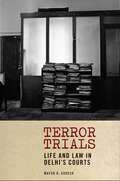
Terror Trials: Life and Law in Delhi's Courts (Thinking from Elsewhere)
By Mayur R. Suresh. 2023
Honorable Mention, Bernard S. Cohn Book PrizeAn ethnography of terrorism trials in Delhi, India, this book explores what modes of…
life are made possible in the everyday experience of the courtroom. Mayur Suresh shows how legal procedures and technicalities become the modes through which courtrooms are made habitable. Where India’s terror trials have come to be understood by way of the expansion of the security state and displays of Hindu nationalism, Suresh elaborates how they are experienced by defendants in a quite different way, through a minute engagement with legal technicalities.Amidst the grinding terror trials—which are replete with stories of torture, illegal detention and fabricated charges—defendants school themselves in legal procedures, became adept petition writers, build friendships with police officials, cultivate cautious faith in the courts and express a deep sense of betrayal when this trust is belied. Though seemingly mundane, legal technicalities are fraught and highly contested, and acquire urgent ethical qualities in the life of a trial: the file becomes a space in which the world can be made or unmade, the petition a way of imagining a future, and investigative and courtroom procedures enable the unexpected formation of close relationships between police and terror-accused.In attending to the ways in which legal technicalities are made to work in everyday interactions among lawyers, judges, accused terrorists, and police, Suresh shows how human expressiveness, creativity and vulnerability emerge through the law.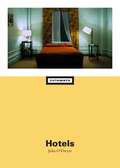
Hotels (Cutaways)
By Jules O'Dwyer. 2025
From Marienbad to the Bates Motel, cinematic hotels are more than a mere backdrop to a film’s action. They actively…
scaffold the formal, aesthetic, and narrative possibilities of cinema. This book takes a journey through spaces of temporary dwelling—hotels, inns, and motels—to delve into the dynamics and contradictions that structure modern life.Along the way, O’Dwyer considers questions of plot and eroticism, labor and globalization, and the ethics and economics of hospitality. Drawing on a broad array of films from European art cinema to experimental adult media, and placing cinema into dialogue with film theory and media history, Hotels explores both how and why the hotel has such a strong purchase on the cinematic imaginary.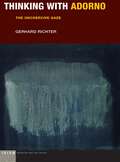
Thinking with Adorno: The Uncoercive Gaze (Idiom: Inventing Writing Theory)
By Gerhard Richter. 2019
What Theodor W. Adorno says cannot be separated from how he says it. By the same token, what he thinks…
cannot be isolated from how he thinks it. The central aim of Richter’s book is to examine how these basic yet far-reaching assumptions teach us to think with Adorno—both alongside him and in relation to his diverse contexts and constellations. These contexts and constellations range from aesthetic theory to political critique, from the problem of judgment to the difficulty of inheriting a tradition, from the primacy of the object to the question of how to lead a right life within a wrong one.Richter vividly shows how Adorno’s highly suggestive—yet often overlooked—concept of the “uncoercive gaze” designates a specific kind of comportment in relation to an object of critical analysis: It moves close to the object and tarries with it while struggling to decipher the singularities and non-identities that are lodged within it, whether the object is an idea, a thought, a concept, a text, a work of art, an experience, or a problem of political or sociological theory.Thinking with Adorno’s uncoercive gaze not only means following the fascinating paths of his own work; it also means extending hospitality to the ghostly voices of others. As this book shows, Adorno is best understood as a thinker in dialogue, whether with long-deceased predecessors in the German tradition such as Kant and Hegel, with writers such as Kafka, with contemporaries such as Benjamin and Arendt, or with philosophical voices that succeeded him, such as those of Derrida and Agamben.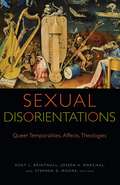
Sexual Disorientations: Queer Temporalities, Affects, Theologies (Transdisciplinary Theological Colloquia)
By Kent L. Brintnall, Joseph A. Marchal, and Stephen D. Moore. 2018
Sexual Disorientations brings some of the most recent and significant works of queer theory into conversation with the overlapping fields…
of biblical, theological and religious studies to explore the deep theological resonances of questions about the social and cultural construction of time, memory, and futurity. Apocalyptic, eschatological and apophatic languages, frameworks, and orientations pervade both queer theorizing and theologizing about time, affect, history and desire. The volume fosters a more explicit engagement between theories of queer temporality and affectivity and religious texts and discourses.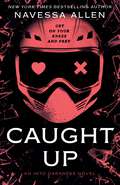
From the author of TikTok's favourite dark and steamy romance, Lights Out, comes Navessa Allen's second book in the New…
York Times bestselling Into Darkness trilogy I want this woman, and I'm a man who always gets what he wants. Nico 'Junior' Trocci knows Lauren Marchetti is off limits. Men like him don't get to have women like her. It's why he pushed her away in high school and still keeps his distance. But Junior follows Lauren online, and now that the shy, bookish girl he remembers is gone, he can't stop obsessing over the strikingly beautiful woman who has taken her place.He's ruthless; a walking red flag. Good thing red is my favorite color. Lauren 'Lo' Marchetti knows Junior is dangerous. He broke her heart once and she won't let him do it again. But as their flirtatious encounters escalate, Lauren starts to remember why she fell for the brooding antihero all those years ago.As old obstacles resurface, Junior and Lauren are forced to face their true feelings for each other and decide just how far they're willing to go for a second chance at love.Caught Up is a fast-paced dark romance with a morally grey male lead. Some themes and scenes may be disturbing to readers. Please check the content warning at the beginning of the book.18+ mature content. Not suitable for younger readers. Readers LOVE Lights Out! 'Hilarious, and wickedly sexy. Yes Josh is a bit of a stalker, but he's a golden retriever one' ⭐⭐⭐⭐⭐'I absolutely adored this book . . . perfect in every single way!' ⭐⭐⭐⭐⭐'Josh and Aly are both magnificent and the spice is next level' ⭐⭐⭐⭐⭐'Really fun, made me laugh so many times I lost count' ⭐⭐⭐⭐⭐'Quite literally perfect. I wanted something spicy but fun and it more than delivered!' ⭐⭐⭐⭐⭐'Proving that a dark romance can still have humour . . . dark of course!!!' ⭐⭐⭐⭐⭐'PERFECTION!' ⭐⭐⭐⭐⭐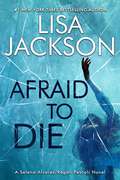
A Montana serial killer is out to taunt and terrorize Detective Selena Alvarez in this psychological thriller by the #1 New…
York Times bestselling author. The town of Grizzly Falls, Montana, is still on edge in the wake of a serial killer&’s capture. Thanks to Detectives Selena Alvarez and Regan Pescoli, the nightmare is over. But a new one is about to unfold. There are two victims so far—their bodies found frozen solid and deliberately displayed. Both are women Selena knew. And each wears a piece of her jewelry. Selena, Regan, and the entire department are on the case, as is P.I. Dylan O'Keefe—a man Selena got too close to once before. But this killer already knows too much about Selena's secret terror, her flaws, and the past she's tried to outrun. And soon he'll show her that she has every reason to be afraid. Selena's partner, Detective Regan Pescoli, and the entire department are on the case, as is P.I. Dylan O'Keefe--a man Selena got too close to once before. But this killer already knows too much about Selena's secret terror, her flaws, and the past she's tried to outrun. And soon he'll show her that she has every reason to be afraid. . .
Dynamic Judaism: The Essential Writings of Mordecai M. Kaplan
By Mel Scult, Emanuel Goldsmith. 1985
Available in a new digital edition with reflowable text suitable for e-readersMordecai M. Kaplan was born in a small Lithuanian…
town on the outskirts of Vilna on a Friday evening in June of 1881. Kaplan was raised in a predominately Jewish atmosphere, which is shown by the fact that he knew his day of birth only by the Jewish calendar until he went to the New York Public Library as a young man to look up the corresponding date. His family was extremely traditional, and his father, Israel Kaplan, was a learned man.Kaplan's concept of Judaism as an evolving religious civilization was widely influential in 20th-century American Jewish life, and his founding of the Reconstructionist Rabbinical College created a new denomination. This book contains a biographical essay and excerpts from all of his major works.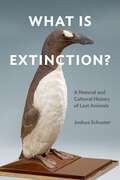
What Is Extinction?: A Natural and Cultural History of Last Animals
By Joshua Schuster. 2023
WINNER, 25th ANNUAL SUSANNE M. GLASSCOCK BOOK PRIZELife on Earth is facing a mass extinction event of our own making.…
Human activity is changing the biology and the meaning of extinction. What Is Extinction? examines several key moments that have come to define the terms of extinction over the past two centuries, exploring instances of animal and human finitude and the cultural forms used to document and interpret these events.Offering a critical theory for the critically endangered, Joshua Schuster proposes that different discourses of limits and lastness appear in specific extinction events over time as a response to changing attitudes toward species frailty. Understanding these extinction events also involves examining what happens when the conceptual and cultural forms used to account for species finitude are pressed to their limits as well. Schuster provides close readings of several case studies of extinction that bring together environmental humanities and multispecies methods with media-specific analyses at the terminus of life.What Is Extinction? delves into the development of last animal photography, the anthropological and psychoanalytic fascination with human origins and ends, the invention of new literary genres of last fictions, the rise of new extreme biopolitics in the Third Reich that attempted to change the meaning of extinction, and the current pursuit of de-extinction technologies. Schuster offers timely interpretations of how definitions and visions of extinction have changed in the past and continue to change in the present.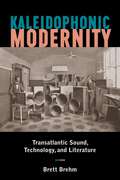
Kaleidophonic Modernity: Transatlantic Sound, Technology, and Literature
By Brett Brehm. 2023
What stories remain hidden behind one of the most significant inventions of the nineteenth century? Kaleidophonic Modernity reexamines the development…
of mechanical sound recording technology by charting the orbits of writers, scientists, and artists in France and the United States. Working between comparative literature, the history of science, and urban studies, Brehm builds a bridge between visual culture and sound studies.Kaleidophonic Modernity places the poet and inventor Charles Cros and his lover, the celebrated concert pianist and salonnière Nina de Villard at the heart of modern aesthetic and scientific vanguards. Cros's scientific endeavors ranged from color photography, to telecommunications, to mechanical sound reproducibility. In his poetry the Surrealists found an ancestor and inspiration. His literary and scientific works prove startling and relevant to predicaments of technological media in his own time and ours. For nearly twenty years Nina de Villard presided over a supremely daring intellectual salon. There, she welcomed manifold literary, artistic, and musical luminaries into a veritable crucible of the artistic avant-garde and precursor to the famous Chat Noir cabaret. Together, these two forgotten but pivotal figures, Cros and Villard, help reframe our thinking on Edgar Allan Poe, Charles Baudelaire, and Walt Whitman, icons of urban modernity who can now be seen and heard in a kaleidophonic light, one that offers a compelling new perspective on modern mediascapes.In elaborating this transatlantic phenomenon, Kaleidophonic Modernity illuminates the prehistory of the phonograph as it intersects with the aesthetics of sound reproducibility, Franco-American literary exchange, Poe’s aesthetic and intellectual legacy, the sounds of modern cities and technologies, and the genealogy of audiovisual experimentation found in such movements as Dada, Futurism, and the sound art of today.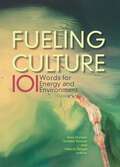
Fueling Culture: 101 Words for Energy and Environment
By Jennifer Wenzel, Patricia Yaeger. 2017
How has our relation to energy changed over time? What differences do particular energy sources make to human values, politics,…
and imagination? How have transitions from one energy source to another—from wood to coal, or from oil to solar to whatever comes next—transformed culture and society? What are the implications of uneven access to energy in the past, present, and future? Which concepts and theories clarify our relation to energy, and which just get in the way? Fueling Culture offers a compendium of keywords written by scholars and practitioners from around the world and across the humanities and social sciences. These keywords offer new ways of thinking about energy as both the source and the limit of how we inhabit culture, with the aim of opening up new ways of understanding the seemingly irresolvable contradictions of dependence upon unsustainable energy forms.Fueling Culture brings together writing that is risk-taking and interdisciplinary, drawing on insights from literary and cultural studies, environmental history and ecocriticism, political economy and political ecology, postcolonial and globalization studies, and materialisms old and new.Keywords in this volume include: Aboriginal, Accumulation, Addiction, Affect, America, Animal, Anthropocene, Architecture, Arctic, Automobile, Boom, Canada, Catastrophe, Change, Charcoal, China, Coal, Community, Corporation, Crisis, Dams, Demand, Detritus, Disaster, Ecology, Electricity, Embodiment, Ethics, Evolution, Exhaust, Fallout, Fiction, Fracking, Future, Gender, Green, Grids, Guilt, Identity, Image, Infrastructure, Innervation, Kerosene, Lebenskraft, Limits, Media, Metabolism, Middle East, Nature, Necessity, Networks, Nigeria, Nuclear, Petroviolence, Photography, Pipelines, Plastics, Renewable, Resilience, Risk, Roads, Rubber, Rural, Russia, Servers, Shame, Solar, Spill, Spiritual, Statistics, Surveillance, Sustainability, Tallow, Texas, Textiles, Utopia, Venezuela, Whaling, Wood, Work For a full list of keywords in and contributors to this volume, please go to: http://ow.ly/4mZZxV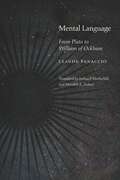
Mental Language: From Plato to William of Ockham (Medieval Philosophy: Texts and Studies)
By Claude Panaccio. 2017
The notion that human thought is structured like a language, with a precise syntax and semantics, has been pivotal in…
recent philosophy of mind. Yet it is not a new idea: it was systematically explored in the fourteenth century by William of Ockham and became central in late medieval philosophy. Mental Language examines the background of Ockham's innovation by tracing the history of the mental language theme in ancient and medieval thought.Panaccio identifies two important traditions: one philosophical, stemming from Plato and Aristotle, and the other theological, rooted in the Fathers of the Christian Church. The study then focuses on the merging of the two traditions in the Middle Ages, as they gave rise to detailed discussions over the structure of human thought and its relations with signs and language. Ultimately, Panaccio stresses the originality and significance of Ockham's doctrine of the oratio mentalis (mental discourse) and the strong impression it made upon his immediate successors.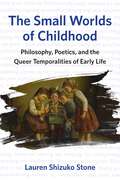
The Small Worlds of Childhood: Philosophy, Poetics, and the Queer Temporalities of Early Life
By Lauren Shizuko Stone. 2025
The Small Worlds of Childhood argues that prose representations of bourgeois childhood contain surprising opportunities to reflect on the temporality…
of experience. In their narratives of children at home in their everyday worlds, Adalbert Stifter, Rainer Maria Rilke, and Walter Benjamin are not only able to shed a unique light on key issues in the history of philosophy. They also offer a queer critique of the normative expectation that the literature of childhood is oriented toward the future. Stone shows that when writers engage in philosophical storytelling, showing children tarrying in quotidian experience, they dislodge childhood from its nostalgic value to grown-ups and the heteronormative demand to grow up. Such stories of children as philosophical subjects thus take on their own lingering, backwards, or all together strange sense of time. Stone demonstrates the necessity of recognizing how texts on childhood—before and beyond Freud—engage literary language in the service of a variety of philosophical attitudes, reminding us how poetic techniques can tell us something extraordinary about moments of ordinary experience and the manner with which humans, and especially children, cognize the world. By bringing canonical German-language literary and philosophical traditions into conversation with current English-language queer approaches, Stone opens a queer counter-history of German and Austrian realist and modernist literature. This title is available from the publisher on an open-access basis.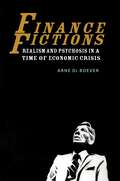
Finance Fictions: Realism and Psychosis in a Time of Economic Crisis
By Arne De Boever. 2018
Finance Fictions takes the measure of what it means to live in a world ruled by high finance by examining…
the tension between psychosis and realism that plays out in the contemporary finance novel. When the things traded at the center of the economy cease to be things at all, but highly abstracted speculations, how do we come to see the real? What sorts of narrative can accurately approach the actual workings of a neoliberal economy marked by accelerating cycles of market crashes, economic and political crisis, and austerity?Revisiting such twentieth-century classics of the genre as Tom Wolfe's Bonfire of the Vanities and Bret Easton Ellis’s American Psycho, De Boever argues that the twenty-first century is witnessing the birth of a new kind of realistic novel that can make sense of complex financial instruments like collateralized debt obligations, credit default swaps, and digital algorithms operating at speeds faster than what human beings or computers can record. If in 1989 Wolfe could still urge novelists to work harder to “tame the billion-footed beast of reality,” today’s economic reality confronts us with a difference that is qualitative rather than quantitative: a new financial ontology requiring new modes of thinking and writing.Mobilizing the philosophical thought of Quentin Meillassoux in the close reading of finance novels by Robert Harris, Michel Houellebecq, Ben Lerner and less well-known works of conceptual writing such as Mathew Timmons’ Credit, Finance Fictions argues that realism is in for a speculative update if it wants to take on the contemporary economy—an “if” whose implications turn out to be deeply political. Part literary study and part philosophical inquiry, Finance Fictions seeks to contribute to a new mindset for creative and critical work on finance in the twenty-first century.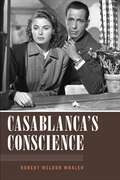
Casablanca's Conscience
By Robert Weldon Whalen. 2024
A new look at a beloved classic film that explores the philosophical dynamics of CasablancaCelebrating its eightieth anniversary this year,…
Casablanca remains one of the world’s most enduringly favorite movies. It won three Academy Awards for Best Picture, Best Director, and Best Adapted Screenplay. It is still commonly quoted: “We’ll always have Paris” and “Here’s looking at you, kid” And who can forget, “You must remember this…a kiss is just a kiss.” Yet no one expected much to come of this little film, certainly not its blockbuster stars or even the studio producing it. So how did this hastily cranked-out 1940s film, despite its many limitations, become one of the greatest films ever made? How is it that year after year, decade after decade, it continues to appear in the lists of the greatest movies ever produced? And why do audiences still weep when Rick and Ilsa part? The answer, according to Casablanca’s Conscience, is to paraphrase Rick, “It’s true.”Much has already been written about the film and the career-defining performances of Bogart and Bergman. Casablanca is an epic tale of love, betrayal, and sacrifice set against the backdrop of World War II. Yet decades later, it continues to capture the imagination of filmgoers. In Casablanca’s Conscience, author Robert Weldon Whalen explains why it still resonates so deeply. Applying a new lens to an old classic, Whalen focuses on the film’s timeless themes—Exile, Purgatory, Irony, Love, Resistance, and Memory. He then engages the fictional characters—Rick, Ilsa, and the others—against the philosophical and theological discourse of their real contemporaries, Hannah Arendt, Dietrich Bonhoeffer, and Albert Camus. The relationships between fictional and historical persons illuminate both the film’s era as well as perennial human concerns. Both the film and the work of the philosophers explore dimensions of the human experience, which, while extreme, are familiar to everyone. It’s the themes that resonate with the viewer, that have sustained it as an evergreen classic all these years.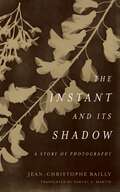
The Instant and Its Shadow: A Story of Photography
By Jean-Christophe Bailly. 2020
A compelling and innovative reflection on the way photography captures and condenses timeTwo photographs, connected by a ladder, separated by…
a century. First, William Henry Fox Talbot photographed a faithfully realistic image of a ladder against a haystack in the English countryside.One hundred years later, an anonymous photographer captured another ladder, “photographed” alongside an incinerated man by the blinding light of the atomic bomb. These two images underpin a poetic and theoretical reflection on the origins of photographic technique, the imaginative power of montage, and the relation of photography to time itself in Jean-Christophe Bailly’s The Instant and Its Shadow, translated into English for the very first time.A rare find of intellectual caliber and theoretical rigor, The Instant and Its Shadow pursues a unique and powerful reflection on the first hundred years of photography’s history and on the essence of the photographic art in general. Inspired by the unexpected coming together of these two iconic images, the book begins by retracing Talbot’s invention of the photographic calotype in the early nineteenthcentury, highlighting the paradox that saw Talbot wishing to imitate the representative arts of painting and drawing while simultaneously liberating the image from any imitative paradigm. This analysis leads Bailly to elucidate photography’s relation to material and visual reality. A meditation on photography’s seeming ability to stop time follows, concluding with the photographs of Hiroshima and the photographic nature of the atomic bomb. Building on an inspired juxtaposition of The Haystack with the Hiroshima photographs, the book becomes a testament to the potency of photomontage, arguing that “the more singular an image, the greater its connective power.” Bailly’s book is at once a lyrical homage to some of the founding texts of photographic theory and a startling reminder of the uncanny power of photography itself. Part theoretical reflection, part lyrical reverie, The Instant and Its Shadow is packed with profound and stellar insights about the medium.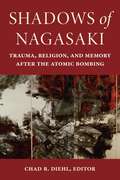
A critical introduction to how the Nagasaki atomic bombing has been remembered, especially in contrast to that of Hiroshima.In the…
decades following the atomic bombing of Nagasaki on August 9, 1945, the city’s residents processed their trauma and formed narratives of the destruction and reconstruction in ways that reflected their regional history and social makeup. In doing so, they created a multi-layered urban identity as an atomic-bombed city that differed markedly from Hiroshima’s image. Shadows of Nagasaki traces how Nagasaki’s trauma, history, and memory of the bombing manifested through some of the city’s many post-atomic memoryscapes, such as literature, religious discourse, art, historical landmarks, commemorative spaces, and architecture. In addition, the book pays particular attention to how the city’s history of international culture, exemplified best perhaps by the region’s Christian (especially Catholic) past, informed its response to the atomic trauma and shaped its postwar urban identity. Key historical actors in the volume’s chapters include writers, Japanese- Catholic leaders, atomic-bombing survivors (known as hibakusha), municipal officials, American occupation personnel, peace activists, artists, and architects. The story of how these diverse groups of people processed and participated in the discourse surrounding the legacies of Nagasaki’s bombing shows how regional history, culture, and politics—rather than national ones—become the most influential factors shaping narratives of destruction and reconstruction after mass trauma. In turn, and especially in the case of urban destruction, new identities emerge and old ones are rekindled, not to serve national politics or social interests but to bolster narratives that reflect local circumstances.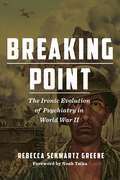
Breaking Point: The Ironic Evolution of Psychiatry in World War II (World War II: The Global, Human, and Ethical Dimension)
By Rebecca Schwartz Greene. 2023
WINNER, SOCIETY FOR MILITARY HISTORY DISTINGUISHED BOOK AWARDS - FIRST BOOKThis book informs the public for the first time about…
the impact of American psychiatry on soldiers during World War II.Breaking Point is the first in-depth history of American psychiatry in World War II. Drawn from unpublished primary documents, oral histories, and the author’s personal interviews and correspondence over years with key psychiatric and military policymakers, it begins with Franklin Roosevelt’s endorsement of a universal Selective Service psychiatric examination followed by Army and Navy pre- and post-induction examinations. Ultimately, 2.5 million men and women were rejected or discharged from military service on neuropsychiatric grounds. Never before or since has the United States engaged in such a program.In designing Selective Service Medical Circular No. 1, psychiatrist Harry Stack Sullivan assumed psychiatrists could predict who might break down or falter in military service or even in civilian life thereafter. While many American and European psychiatrists questioned this belief, and huge numbers of American psychiatric casualties soon raised questions about screening’s validity, psychiatric and military leaders persisted in 1942 and 1943 in endorsing ever tougher screening and little else. Soon, families complained of fathers and teens being drafted instead of being identified as psychiatric 4Fs, and Blacks and Native Americans, among others, complained of bias. A frustrated General George S. Patton famously slapped two “malingering” neuropsychiatric patients in Sicily (a sentiment shared by Marshall and Eisenhower, though they favored a tamer style). Yet psychiatric rejections, evacuations, and discharges mounted.While psychiatrist Roy Grinker and a few others treated soldiers close to the front in Tunisia in early 1943, this was the exception. But as demand for manpower soared and psychiatrists finally went to the field and saw that combat itself, not “predisposition,” precipitated breakdown, leading military psychiatrists switched their emphasis from screening to prevention and treatment. But this switch was too little too late and slowed by a year-long series of Inspector General investigations even while numbers of psychiatric casualties soared. Ironically, despite and even partly because of psychiatrists’ wartime performance, plus the emotional toll of war, postwar America soon witnessed a dramatic growth in numbers, popularity, and influence of the profession, culminating in the National Mental Health Act (1946). But veterans with “PTSD,” not recognized until 1980, were largely neglected.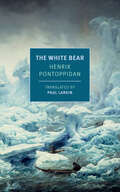
The White Bear
By Henrik Pontoppidan. 2025
Love, faith, and the political mingle in these two short novels by a Nobel Prize-winning Danish author. One about a…
young couple making a new life in Rome, the other about a priest who goes to live among native peoples in Greenland, both books explore the reaches of the human heart through their complex and unforgettable characters.Henrik Pontoppidan, the Danish Nobel laureate, is admired for the concentrated force of his novellas as much as for long, populous, world-encompassing novels like A Fortunate Man, and here are two of those novellas, newly and brilliantly translated by Paul Larkin.The White Bear follows the fate of the odd, gangly, red-bearded Thorkild Müller. Born in rural Jutland and destined for the ministry, Thorkild proves to be a poor student and is assigned to a remote Inuit tribe in Greenland. There, with his mythic-looking staff and dogskin skullcap, he becomes known as the White Bear—a beloved legend among the locals and a freewheeling embarrassment to his fellow priests. Grown old, he returns to Denmark, where again his flock adores him while his fellow men of cloth try to tame the "whirling dervish in their midst." In the end Thorkild mysteriously disappears, presumably back to the snow wilderness of Greenland.The Rearguard, on the other hand, is a marriage story. Newlyweds Jørgen Hallager and Ursula Branth are as different as night and day. The brash son of a poor village teacher, Jørgen is an avowed socialist whose revolutionary beliefs translate into his work as a painter of social realism; Ursula comes from a conservative, upper-middle-class family. At first, as they start their married life in Rome, they each try to change the other's worldview with arguments and threats, but as time wears on and they wear each other down, it becomes clear there can be no reconciliation. It is a tragic tale of art and idealism, individuality and love.This translation was funded in part by a grant from the Danish Arts Foundation.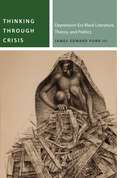
Thinking Through Crisis: Depression-Era Black Literature, Theory, and Politics (Commonalities)
By James Edward Ford III. 2020
Winner, 2020 William Sanders Scarborough Prize, Modern Language AssociationHonorable Mention, MSA First Book PrizeIn Thinking Through Crisis, James Edward Ford…
III examines the works of Richard Wright, Ida B. Wells, W. E. B. Du Bois, Zora Neale Hurston, and Langston Hughes during the 1930s in order to articulate a materialist theory of trauma. Ford highlights the dark proletariat’s emergence from the multitude apposite to white supremacist agendas. In these works, Ford argues, proletarian, modernist, and surrealist aesthetics transform fugitive slaves, sharecroppers, leased convicts, levee workers, and activist intellectuals into protagonists of anti-racist and anti-capitalist movements in the United States.Thinking Through Crisis intervenes in debates on the 1930s, radical subjectivity, and states of emergency. It will be of interest to scholars of American literature, African American literature, proletarian literature, black studies, trauma theory, and political theory.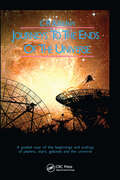
Journeys to the Ends of the Universe presents a tour through the universe from the big bang onward. The book…
explores the limits of knowledge where scientific fact overtakes and merges with the wilder speculations of science fiction. The beginnings of galaxies, stars, planets, and even life itself are related back to the raveled turmoil of the first few seconds and years of life in the cosmos. The journey continues past the ultimate fate of the solar system to probe the nature of supernovae. The future of galaxies, clusters of galaxies, super-clusters of clusters of galaxies, and so on leads toward the finale, where the author provides some bizarre musings of physicists and astronomers, suggesting possible destinies for the universe stretching its present age billions of times into the future.